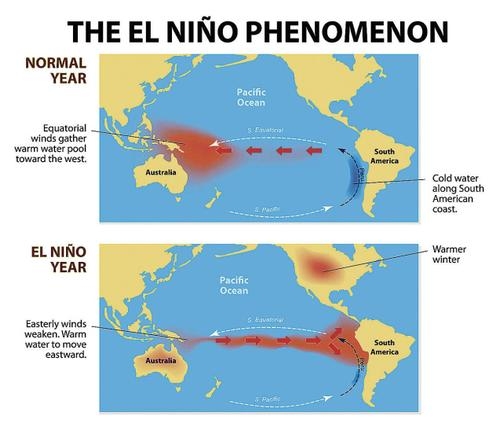
For the Napa Valley, El Niño refers to a weather pattern in which warming sea surfaces cause heavier-than-average winter rains and wind with warmer-than-normal temperatures.The U.S. Climate Prediction Centerhas predicted 65 percent likelihood that we will feel the effects of El Niño as summer ends, with that probability rising to nearly 80 percent by the end of the year. The National Oceanic and Atmospheric Administration says that this weather pattern usually continues for nine to twelve months.
Because of the current drought, the idea of a wet winter is welcome to me. The coming rains are too late for a number of my trees and shrubs, which are either dead or have dead branches. And the high winds that accompany El Niño storms could blow any of these trees down. Clearly I need to trim dead branches and trees and make sure weak plants are staked properly.
El Niño storms often dump massive amounts of rain in a short time, creating flash floods and heavy water build-up in yards. You can find some good suggestions on how to handle storm water as well as how to collect it for future use at www.countyofnapa.org. In the search box, type “slow it spread it sink it” to find an online reference guide by that name.
Since good drainage is extremely important to plant health, my other pre-storm chores involve clearing a place for the rain water to go. These tasks include clearing weeds from the run-off ditches in my yard as well as cleaning out rain gutters and spouts.
Highly saturated soils make it hard for plants to survive. In wet soil, t is almost impossible for roots to take up all the oxygen that the plant needs, which causes the roots to decay. Deep roots are the first to rot. If the condition continues shallower roots will also be damaged. Even plants that don't appear to be flooded may have problems during extended wet weather. And you may not see the damage until next summer. One of the best defenses for your winter vegetable garden is to make sure you have well-drained soil and to plant in mounds.
After an El Niño season, everything may appear normal in your garden until summer temperatures top 90°F. After the 1997-98 El Niño season, Napa County farm advisor Dean Donaldson warned Master Gardeners about this phenomenon in the group's newsletter. “Sometimes tree growth is simply stunted,” wrote Donaldson. “Usually, however, people observe their beautiful trees and shrubs suddenly turning from green to yellow or reddish brown. Usually it is the entire tree and it happens within a few days of hot weather. Insects are attracted to those weakened trees and often get the blame. If the whole tree dies, you can blame El Niño.”
When those record-breaking El Niño rains subsided and weather warmed up, fungal and bacterial pathogens emerged on foliage. Many trees and shrubs evidenced phytophthora root and crown rot. Slime molds appeared on soil surfaces, and snails and slugs proliferated.
Anthracnose, fire blight, and powdery mildew all thrive after a mild, wet spring. When you see evidence of these diseases on plants, cut out and discard the affected material immediately. Sanitation is the number-one way to keep these diseases from spreading. Iron chlorosis may also be a problem in wet soils.
The best thing we can do for our gardens before an El Niño-influenced winter is to create good drainage. Afterward, watch for symptoms of root rot, fungus or bacterial diseases.
Garden Tour:The UC Master Gardeners of Napa County invite you to their sixth garden tour, “Down the Garden Path,” on Sunday, September 13. On this self-guided educational tour you will see seven gardens by Master Gardeners in and around the City of Napa. These gardens illustrate how Napa County Master Gardeners use University of California research-based horticultural information to develop and maintain their own gardens.
Tickets: $30 Advance/ $35 Day of Event. Purchase tickets at http://ucanr.edu/ucmgnapa. Or you can purchase tickets at the UC Master Gardener office (address below). For more information, call 707-253-4143.
Workshop: The UC Master Gardeners of Napa County will host a free workshop on “Worm Composting” on Saturday, September 26, from 9 a.m. to 11 a.m., at the Napa Valley Museum, 55 Presidents Circle, Yountville. Explore worm composting, an ideal solution for composting kitchen scraps and returning the nutrients to your soil, especially when outdoor space is limited. Co-sponsored by Napa Recycles! Free Online Registration.
Master Gardeners are volunteers who help the University of California reach the gardening public with home gardening information. U. C. Master Gardeners of Napa County ( http://ucanr.org/ucmgnapa/) are available to answer gardening questions in person or by phone, Monday, Wednesday and Friday, 9 a.m. to Noon, at the U. C. Cooperative Extension office, 1710 Soscol Avenue, Suite 4, Napa, 707-253-4143, or from outside City of Napa toll-free at 877-279-3065. Or e-mail your garden questions by following the guidelines on our web site. Click on Napa, then on Have Garden Questions? Find us on Facebook under UC Master Gardeners of Napa County.